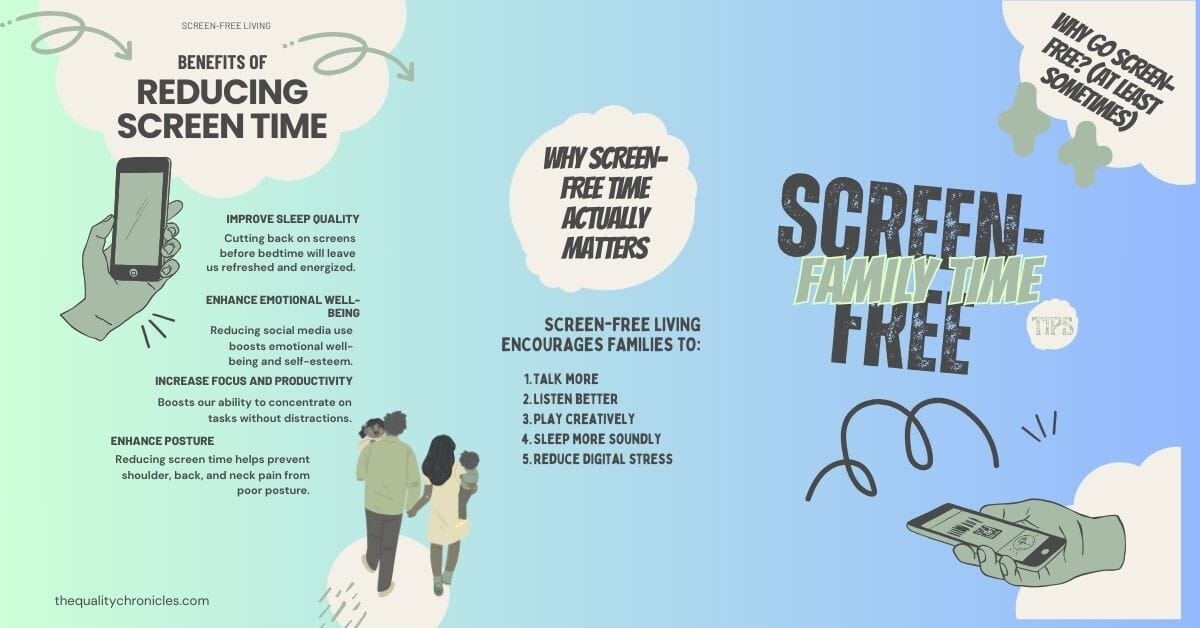
Why Go Screen-Free? (At Least Sometimes)
Screen-free living isn’t about throwing your phone into a lake. It’s about taking back your time, energy and attention from constant digital demands. Whether it’s work pings, kids’ videos or mindless scrolling, screens can silently steal moments that matter.
If your family feels disconnected or burnt out, screen-free living might be the refresh you didn’t know you needed.
👉 Related: Family Challenges: 24-Hours Screen-Free!
What’s a Digital Detox, Anyway?
A digital detox is a short, intentional break from screens. That includes phones, tablets, TVs, laptops even smartwatches.
Try a:
Need something outdoorsy? Explore Nature Day Trips with No Devices.
Why Screen-Free Time Actually Matters
Screen-free living encourages families to:
- Talk more
- Listen better
- Play creatively
- Sleep more soundly
- Reduce digital stress

You don’t have to delete every app. You just need mindful routines that protect quality time. Start with easy wins like No-Tech Dinner Conversations Starters or Quality Flow Everyday.
7 Real-Life Routines for Screen-Free Living
1. Make Screen-Free Zones
Set up screen-free spaces like the dining area, bedrooms, or the car. Fill these areas with books, crafts, puzzles, or journals.
Guide: How to Create No-Screen Zones at Home
2. Use Time Blocks
Create tech windows—like 30 minutes after school or before dinner—and enforce device downtime after 8 PM.
Pair it with:
- 10-Minute Analog Activities
- Outdoor play or family chats
3. Start the Day Device-Free
Resist checking your phone first thing. Instead, try stretching, journaling, or making breakfast together.
More tips: Morning Routines Without Your Phone
4. Mini Detoxes for the 9-to-5 Crowd
Not just for kids but grown-ups too benefit from scheduled screen breaks, too.
Try this at work: Digital Detox for the 9-to-5 Life
5. Weekly Creativity Hour
Block out one hour per week for something artistic. Paint, bake, knit, build Lego cities—just no screens.
See: Weekly Tech-Free Rituals for the Family
6. Family Game Night
Games like Uno, Jenga, or Pictionary bring people together—no WiFi required.
Try rotating who picks the game each week. Set up a “tech drop zone” to keep devices away.
7. Tech-Free Travel
Road trips are the perfect excuse to unplug. Use paper maps. Sing songs. Play Road Trip Games for Kids (No Phones Required).
Screen-Free = Fun? Yes! Here’s How to Make It Stick
Mix things up with:
- Backyard camping
- Storytelling contests
- Cooking challenges
- Storytelling Nights with Kids
Kids often resist change, but when they’re included in planning, screen-free moments become something they look forward to.
The Benefits of Screen-Free Living
💬 1. Stronger Conversations
More eye contact. More laughs. More real talk.
Try this: No-Tech Dinner Conversations Starters
2. Mental Health Boost
Breaks from blue light and social comparison help improve sleep, focus, and mood.
External Resource: American Academy of Pediatrics: Media Guidelines for Families (DoFollow)
3. Creativity Unleashed
Boredom is the mother of invention. Without screens, children (and adults) start imagining, building, and problem-solving.
Learn how: How to Encourage Kids to Embrace Boredom
⏱️ 4. Productivity + Purpose
When devices are down, you’re free to focus on family goals, hobbies, and health. Teaching Mindfulness Without Apps can help.
But Wait—What About the Pushback?
Expect some resistance. Here’s how to work through it:
- Start small with time blocks
- Replace screen time with fun time
- Create visual trackers or screen-free rewards
Model good behavior: Role Modeling Screen Discipline as Parents
❓FAQs About Screen-Free Living
What does it mean to be screen-free?
Being screen-free means limiting or eliminating the use of digital devices like smartphones, tablets, TVs, and computers during specific times or in certain areas of life—especially when they interrupt connection, creativity, or calm.
How to live without screens?
Start by designating screen-free zones, scheduling tech-free hours, and replacing screen time with meaningful alternatives like reading, outdoor play, or family conversations. You don’t need to quit all screens; just use them more mindfully.
How to become a screen-free home?
Create house-wide screen-free rituals such as no phones at meals, screen-free bedrooms, and tech-free weekends. Encourage open conversations about screen use and lead by example as a parent or caregiver.
What is the 3 6 9 12 rules for screen time?
This popular guideline suggests: no screen exposure before age 3, no personal screens before age 6, supervised use with limits until age 9 and responsible, independent screen use after age 12. It emphasizes age-appropriate access and boundaries.
Is screen-free living realistic for busy families?
Yes! Start with 15–30 minutes a day and work your way up. It’s more about consistency than duration.
What counts as screen time?
Anything with a digital display—TV, smartphone, tablet, laptop, e-reader, etc.
Can screens still be educational?
Absolutely. The goal isn’t to ban screens but to balance them. Learning apps and family movies can still be part of screen-free families—just mindfully used.
What about teens?
Involve them in the process. Let them help create tech-free rituals. They’re more likely to follow rules they help build.
Final Thought: Embracing a Screen-Free Lifestyle
You don’t need to be perfect—just present. Screen-free living is a tool, not a test. Use it to build rhythms, rituals, and relationships that light up your home.
Even a few screen-free minutes a day can change the tone of your evenings and deepen your bonds.
So breathe. Unplug. And start small.
🌟 Want More?
- 📚 Teaching Mindfulness Without Apps
- 👨👧 Role Modeling Screen Discipline as Parents
- 🌞 Digital Detox for the 9-to-5 Life
More from external sources https://www.amazon.com/Childhood-Unplugged-Practical-Screens-Balance/dp/0865719829


